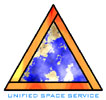A Traveler’s Guide to the Solar System
by Ron Miller and William K. Hartmann
(Workman, 1993, 208 pages, $25.95 cloth, $14.95 paper)
Reviewed by Michael P. Kube-McDowell
Every year, millions of us make long journeys to experience the wonders of the Grand Canyon, a mile-deep gouge across 300 miles of western plateau. But the grandest canyon of all, Valles Marineris, is carved on the face of the planet Mars–a wound four miles deep, 3000 miles long, and so wide that a visitor standing atop one rim wall would be lucky to be see the other side.
Yellowstone National Park, America’s oldest, continues to enthrall travelers with its hot springs and dramatic geysers, a geothermal showcase unequalled on Earth. But Old Faithful pales beside the turbulent lava lakes and dramatic sulfur volcanoes of Jupiter’s moon Io, the most volcanically restless body in the Solar System.
Wonders like Io and the Valles Marineris are still beyond the reach of even the most wealthy vacationer and the boldest explorer. They belong to the great wilderness that lies beyond the comfortable back yard of Earth, our home. But, still, they call to us–a call we answer with spacecraft named Viking and Voyager, Mariner and Galileo, with the machinery of science and the poetry of fiction and art.
Wonder, science and art intersect in the newly updated edition of Ron Miller and William Hartmann’s The Grand Tour. Gathered together between its covers are both the fantastic discoveries of space science in the 1980s and the human dimension of an encounter with nature’s grandeur.
Drawing on the journeys of robot explorers with electronic eyes, Miller’s splendid paintings place you on the shore of a methane lake on Titan, let you look out from the icy surface of Ganymede at the banded disc of Jupiter hanging in a black sky, and float you in the high clouds of Saturn with the planet’s stunning rings arching overhead.
Hartmann’s clear text paints another kind of picture of the nearly fifty worlds covered by The Grand Tour--of a journey of human discovery, with more questions still unanswered than answered. The unusual organization of the book–from largest to smallest, Jupiter to asteroid 1991 BA–highlights the diversity and dynamism of the Sun’s family.
Rich enough in detail to serve as a reference, yet accessible enough for everyday readers, The Grand Tour is a splendid guide for voyages of the imagination to the very real wonders that await their first human visitors. Clementine is off on a return visit to the Moon, and Galileo is fast approaching Jupiter. Where are you going this year?
–Science fiction writer Michael P. Kube-McDowell (Exile, The Quiet Pools) recently received a Distinguished Alumni Award from Indiana University South Bend.

